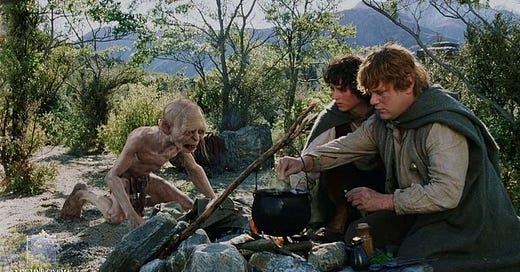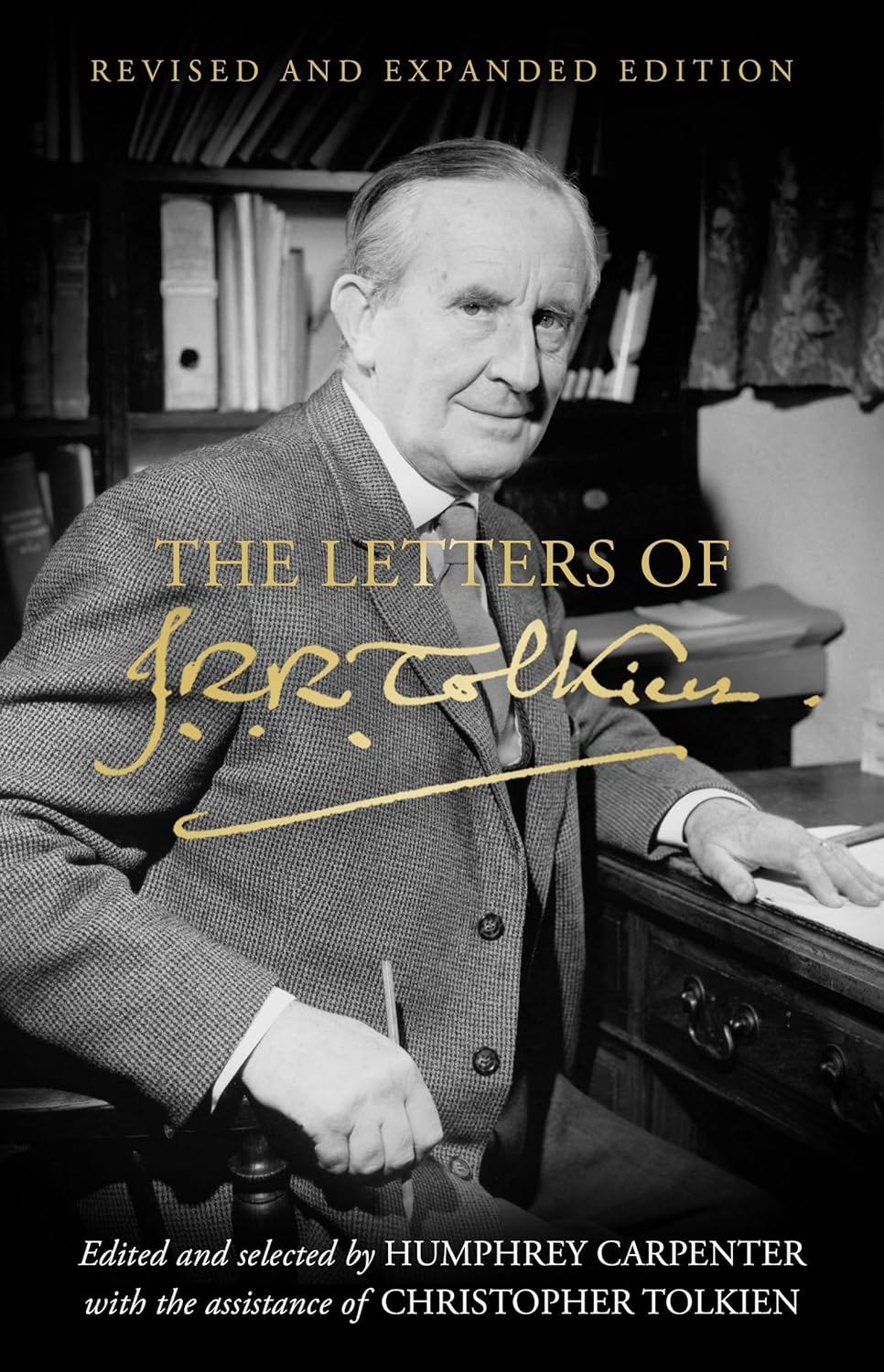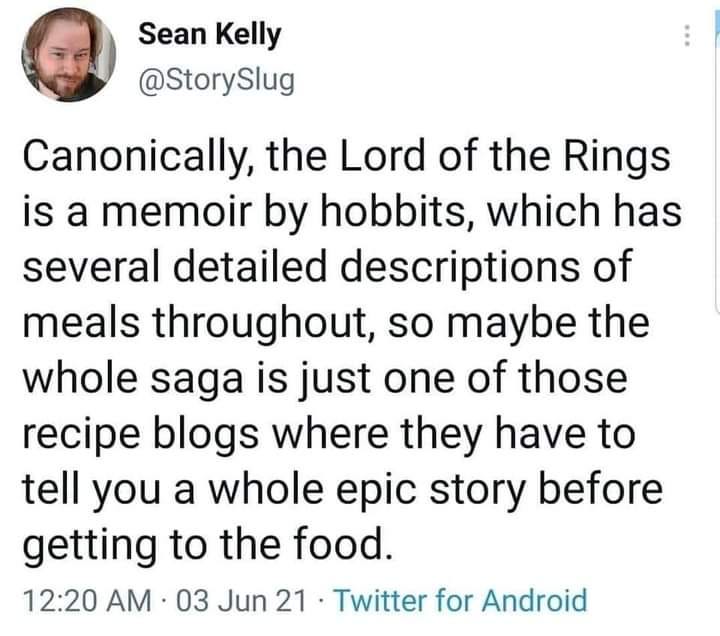Tolkien’s Special Soup Recipe
What creating a story and cooking a soup have in common
Mae govannen, friends! Josh here. This week’s newsletter is a guest piece from
. A few months ago I joined Keela on her podcast, 11ses and immensely enjoyed our conversation. Keela has just started her own Substack, and you can find her on Instagram as well.In today’s piece, Keela discusses Tolkien’s idea of the “cauldron of story” and applies it to show how it can form a “recipe” of sorts for individual creators to follow. I enjoyed reading it and am excited for you all to read it too! Be sure to subscribe to her Substack if you enjoy and appreciate it!
Tolkien’s Special Soup Recipe
What creating a story and cooking a soup have in common
In “On Fairy-Stories,”1 J.R.R. Tolkien goes into this in-depth metaphor he calls the “cauldron of story” where he likens stories to soup, so I thought I would provide my own interpretation of what his soup recipe might look like. And in true recipe fashion, I’m going to rant for a few paragraphs before we get to the good stuff.2
When I mention soup and Tolkien in the same sentence, you may think we’re going to break down the ingredients in Éowyn’s sludge, but luckily that is not the case. “By ‘the soup,’” Tolkien explains, “I mean the story as it is served up by its author or teller, and by ‘the bones’ its sources or material…” According to Tolkien, this soup we are discussing is a finished story, and the ingredients are collected from other stories and experiences from the storyteller’s life.
Whether or not you consider yourself a writer or storyteller, we each have been brewing our own cauldron of this special soup. Each time you take in literature, or experience a memory, or have a conversation with a friend, you are adding ingredients to the story that makes up your life. Tolkien even comments on the fact that some ingredients get added without conscious thought. Some get added even if we’d rather they not: “...the Pot of Soup, the Cauldron of Story, has always been boiling, and to it have continually been added new bits, dainty and undainty.”
If ingredients can be added not just consciously but unconsciously, we must try to be careful and aware of which ones we let into our soup. Much like we become who we hang out with, we become the stories we ingest. I notice I start talking all fast and sarcastic when I start my yearly Gilmore Girls rewatch. I repeat quotes without remembering if they came from a TikTok, a news article, or a conversation with my husband. I may be more likely to let a cussword pass my lips after reading Stephen King (in fact, he’s the reason I wrote that as one word). As a Christian I know that out of the mouth the heart speaks3 and therefore we should think about whatever is true, honorable, just, pure, lovely, and commendable.4 I know that is so hard with the world today, but, thinking like a chef, how can we do our best to intentionally add good ingredients to our soups and also turn even the bitter ingredients that we can’t completely prevent from seeping in into something sweet?
Once we become aware of our individual cauldrons brewing away, it’s time to actually start cooking! Like in any recipe, we must be intentional about what ingredients we scoop up when serving. Tolkien says, “But if we speak of a Cauldron, we must not wholly forget the Cooks. There are many things in the Cauldron, but the Cooks do not dip in the ladle quite blindly. Their selection is important.” In order to become cooks (storytellers), we must be aware of the ingredients (stories) in our soup, taking careful notice of what we share with our guests. Like we might balance the salt and fat with acid or heat (totally stole that from Food Network), we must pick and choose which pieces we want from other stories and disregard the rest. Pablo Picasso said, “good artists borrow, great artists steal,” not in a plagiaristic way, but in an inspirational way. In fact, it’s impossible not to steal because the Bible also says there is nothing new under the sun,5 and I personally believe all our stories go back to The Story of Christ, but I’m getting a bit off topic here.6 Ultimately, if we want to be storytellers, we need to assess the bits of story making up our psyche, and tell the good parts in our own unique way.
So now you may be thinking, why would I want to be a good storyteller? To that I would argue that stories are imperative to build connections. We make friends by sharing anecdotes until we find common ground. We share our faith by describing specific instances in which God moved in our lives. We fall in love as two separate stories weave together into one. We escape the humdrum of reality by reading, watching, and/or playing through stories. And just like how in Ratatouille “anyone can cook,” anyone can tell stories! We do not have to have a PhD in literature to understand what early humans learned around a campfire. We don’t even have to have an insane roller coaster of a life in order to have a good story. We each have our own experience with love and beauty and meaning and I think that’s worth sharing.
No one else has read all the exact same books you have read. No one else has gleaned the same meaning from said books. Because no one else has your personal experience and perspective on the world. Your soup is delicious and unique and yours, so why not gather some friends and host a dinner party?
For inspiration, here’s what I imagine Tolkien’s recipe is:
Story Soup
by J.R.R. Tolkien
Cook time: One lifetime
Serving size: One ladle-full
Nutritional Information: Good for the soul
Ingredients:
10 cups of water of life
Bones of faith and values
5 cups of various vegetables from the garden of stories, chopped (Editor’s Note: try some PO-TA-TOES!)
6 herb sprigs trimmed from your personal experiences
Salt and pepper to taste
Instructions:
Get out a large cauldron. If you don’t have one forged in the mines of Moria, store bought is fine.
Add a liquid base of existence and get the heat going until it simmers.
Add bones of your faith and values. I like to establish the most prominent ingredients first, so they have time to stew.
Add chopped up pieces of your favorite stories, like philology texts, Germanic poetry, and Norse myths.
Sprinkle sprigs of your personal experiences like my time in WWI or with my friends at The Eagle and Child.
Let simmer. The longer you let it go, the more time the ingredients have to meld together.
Taste frequently, adding, subtracting, and tweaking until you have the perfect bite. Serve it with lembas bread to the ones you love. Then continue to taste and tweak and dip your ladle again and again for different bites as needed throughout your life.
To Discuss:
Had you heard about Tolkien’s concept of the “cauldron of story” before reading Keela’s post? What’s your reaction?
Are you a “jump to the recipe” sort of person or do you like reading the stories before the recipe?
I’m not the only one that gets really sad thinking about how no one got to eat Sam’s delicious stew he spends so long cooking and describing to Gollum, right??
Appendices
On November 9 in the UK and November 14 in the US, a revised and expanded version of Tolkien’s Letters will be released! Pre-order or order it today (depending on your location and when you’re reading this):
📚 Amazon 📚 Bookshop.orgHere’s the link to when I joined Keela on her podcast:
❌ All typos are totally on purpose
🔗 Links may be affiliate, which is a free-to-you way to support this newsletter where I earn a small commission on items you purchase
💌 Was this email forwarded to you? Subscribe here
🗃️ Can’t wait till next Thursday for more content? View the archive
🎯 Interested in sponsoring this newsletter? (4.1k+ subscribers) Email me at JRRJokien@JRRJokien.com
Tolkien, J.R.R. “On Fairy-Stories.” 4 Dec. 1947.
Matthew 12:34
Philippians 4:8
Ecclesiastes 1:9
Editor’s note: if you want to follow this rabbit trail and read more from Tolkien’s “On Fairy-Stories” about how all stories trace their truth back to the Story of Christ, I wrote about it last year: “While all successful fantasy hopefully draws upon and is grounded in reality in manifold ways, Tolkien considers this joy not just a drawing upon reality but a ‘glimpse of the underlying reality or truth’ of the primary world (“On Fairy-Stories,” 88). For a moment the curtain is drawn back, and we experience something ultimate, something absolute and real. And what truth is Tolkien, a devout Catholic from boyhood, ultimately referring to? The life, death, and resurrection of Jesus Christ.”
Read the rest here:
What Easter Has to Do With Fairy-Stories
On Easter and Fairy-Stories It’s the week of Easter, so it’s the perfect time to discuss Tolkien’s concept of Eucatastrophe and how he saw Easter’s place in his understanding of fairy-stories. According to Tolkien—who coined the term in his essay “On Fairy-Stories”—a ‘eucatastrophe’ is “the consolation of fairy-stories, the joy of the happy ending: or mor…












Hey email readers: yes, the version that got sent out to you had Gollum misidentified as Bilbo in the image caption! That's my bad, not Keela's: I captioned the still from The Two Towers and I don't know what I was thinking 😅. It's already fixed on the web version. Congrats: you passed the "close reading test" if you noticed. Thanks for reading closely!
I confess I am a “jump to recipe” person unless it’s something unfamiliar and new, like the first time I made butter chicken. But who needs the whole story when you’re only trying to find out the temp and time for cooking tater tots in the air fryer? (380 for 9-10 minutes, by the way)